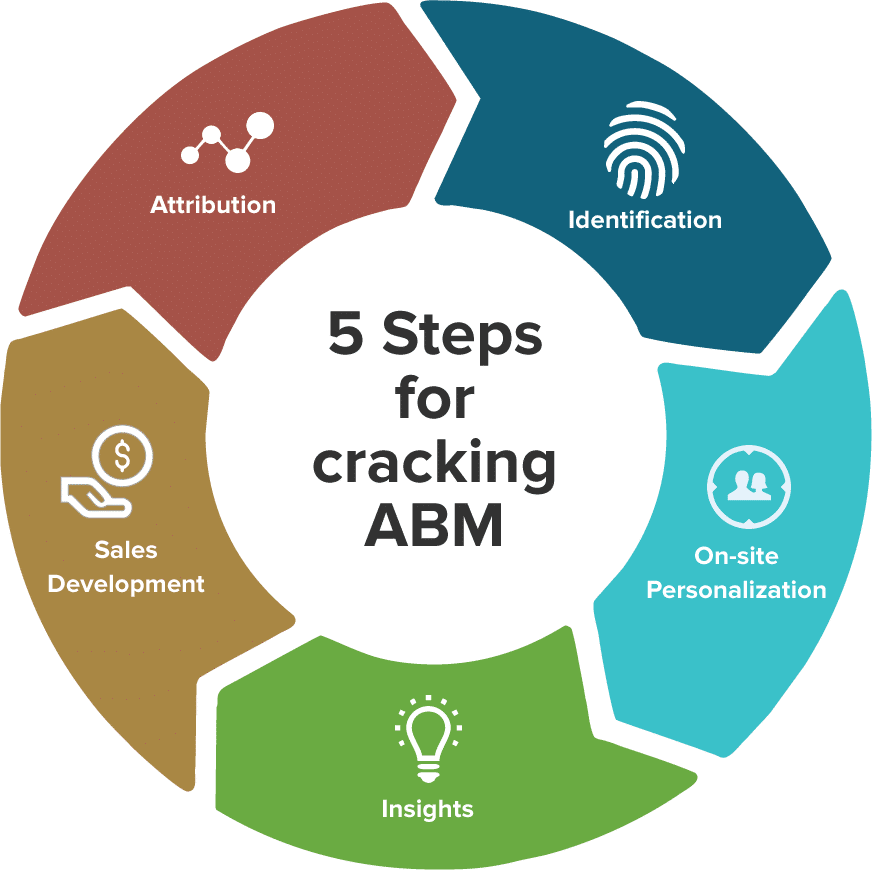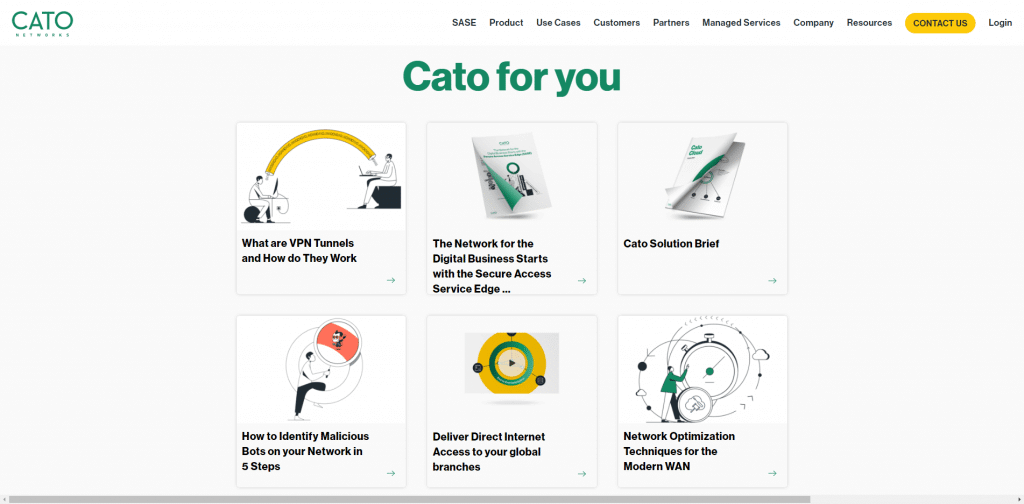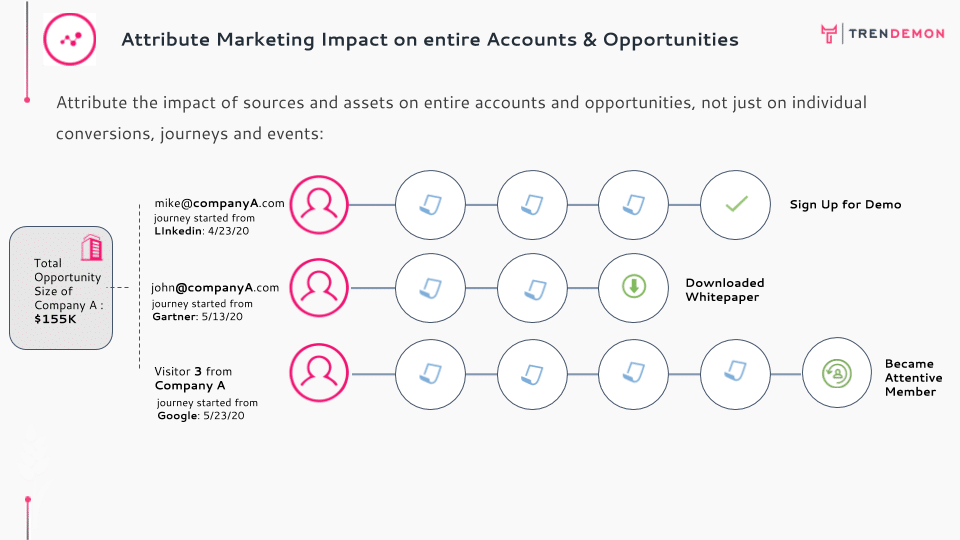5 ways Account based Personalization and Attribution can accelerate your pipeline

How is ABM helping marketers adapt to the coronavirus era? As with many transitions (like work from home), Covid-19 has accelerated many organizational transformations.
One of those transitions is the shift to ABM. This is in part due to the growing focus many companies now give to their existing customers and pipeline. Even before coronavirus, over 45% of marketers report achieving more than double the ROI from ABM.
So, we wanted to break down ABM into 5 specific stages companies leverage. We can see more focus on Account based Personalization and Account based attribution insights (through the lens of content marketing analytics) to accelerate their pipeline:

1. Account-based Identification
See if your website is being visited by relevant people and companies.
In B2B websites, the vast majority of the traffic is at the pre-lead stage. Account-based Identification identifies if an anonymous visitor has arrived from an IP of a target company. Although during Covid-19 more and more people are WFH, we still see a high rate of traffic identification (probably due to the fact that many people use VPNs to access their work networks).
This pre-lead identification stage can help you in 2 main ways:
1) See whether your demand generation efforts are bringing in relevant people to your digital assets.
2) You can personalize the messages and paths of those visitors to be more relevant to what they’re seeking.

2. Account based personalization
Show specific calls to action and content to target accounts.
The ability to identify incoming visitors through reverse-IP lookup opens up a whole new world of possibilities. On their end, you can improve their customer experience and content journeys. For example, people from specific industries can be shown relevant case studies to their domain or focus on specific capabilities of the product.
For example, a cyber security company can show a call action to visitors from financial institutions prompting them to view a case study from the banking industry. Furthermore, with on-site content personalization, you can create tailored content journeys for those types of visitors. This significantly increases engagement with your content. Over 78% of people will only engage offers if they have been personalized to their previous engagements with the brand (source):

3. Account Based Insights
Encourage your Sales Development teams to have more meaningful conversations.
One of the main benefits of account-based marketing is that it aligns marketing and sales teams around shared objectives. The first part in this alignment is a better flow of relevant information between the sales and marketing teams. For example, SDRs can be notified when a prospect has returned to their website and engaged with specific content assets. This provides important context for the SDR when they reach out.
Just like offering a personalized experience on the website, SDRs can now have a more personalized, contextual conversation with their prospects and leads.

4. Account Based Content Hubs
Empower sales development teams with curated content hubs
A big challenge we see marketing and sales development teams struggle with is how to curate relevant content for specific audiences. Too often, content is scattered across different platforms and formats. It’s a lot of work to organize it effectively for viewing.
In recent years, we’ve been seeing a rise in content hub solutions from great companies like Uberflip and Pathfactory, as well as Trendemon (yes, that’s us.) These solutions offer extensive systems for building and managing content hubs. This is another form of account based personalization.
The idea is that instead of having to manually curate articles, papers and videos, marketers can easily prepare specific hubs (dedicated URLs) for SD teams. Those destinations can be sent to prospects to offer them a personalized resources center.
Why is it imperative to arm your SDRs with high quality, curated and relevant content?
67% of top-performing sales organizations support their sales enablement efforts with content. In addition, 82% of buyers viewed between five to eight pieces of content from a winning vendor (source).

5. Account Based Attribution
Measure what matters in your customer journeys.
Finally, you want to be able to attribute various activities and assets to business outcomes. The goal here is to be able to close the feedback loop between demand gen campaigns, experiences on digital assets, and revenue.
Not to be too cheesy, but sometimes it really is about the journey, not the destination. Although you might be tempted to focus all of your attention on what went right in a successful lead’s journey, you need to expand your horizons.
There’s a lot of important data in the behind the scenes, or rather the people who didn’t complete the journey in becoming a lead.
Just because an engaged visitor doesn’t become a lead, does not mean their journey is irrelevant. That failed lead might tell you what what went wrong, and where you can better guide your customers.
Plus, that might not have even been a failed lead at all. There are multiple people involved in the decision making process. It could have been another person doing background research that led to that key decision.

To sum it all up, it’s important to think about the entire process. Be aware of the individual steps and the hand offs between them.
Deployment of ABM technologies, and specifically account based personalization and attribution solutions, can be somewhat daunting.
We get it. There’s a lot of moving parts. But it’s also an incredible opportunity to level up your lead generation.
Want to try it out, minus all the massive upfront infrastructural investments?